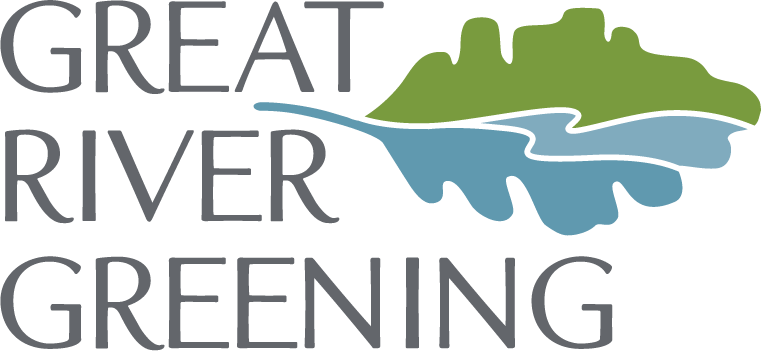Fighting Climate Change: How Great River Greening Makes a Difference
Healthy natural areas are a powerful tool in our fight against climate change. Pictured above are volunteers planting trees at Westwood Hills Nature Center in St. Louis Park.
Great River Greening is a leader in land and water restoration efforts across Minnesota, transforming more than 400 natural areas into beautiful, healthy places to explore nature since our beginning.
But our work does more than improve outdoor places. By restoring green spaces and waterways - as we’ve done alongside thousands of volunteers and donors for 27 years - we’re also fighting the harmful effects of climate change.
Climate Change: What’s Happening in Minnesota?
In Minnesota, our climate has warmed three-degrees over the last century and natural precipitation has increased by an average of 3.4-inches. While this doesn’t seem like much, slowly rising temperatures and rainfall have led to a decline in wildlife and plant populations, poor air and water quality, increasingly extreme weather patterns, more frequent natural disasters, and excessive heat and droughts. These climate shifts result in reduced agricultural yields, declining water supplies, increased health issues from higher temps and lack of clean air, and fewer opportunities to head outdoors and enjoy nature. In essence, climate change – as marginal as it may seem – greatly threatens our quality of life.
Fortunately, it’s not too late to turn things around.
Our Solution: Climate Resiliency
Great River Greening builds healthy, resilient natural areas that sustain wildlife, protect water quality, and give us beautiful places to spend time in nature. Our work also strengthens native ecosystems so they can withstand – even reverse - extreme weather patterns caused by climate change.
Our land and water restoration projects directly support the State of Minnesota’s Climate Action Plan, helping to reduce carbon emissions by 45% by 2030.
Climate Resiliency Activities
Native grasses and wildflowers have deep, complex root systems that sequester harmful toxins.
Climate Resilient Greenery: By increasing biodiversity and introducing plants (e.g., grasses, trees, and wildflowers) that are adapted to warmer and drier climates, vegetation is more likely to survive as temperatures shift. This may include, for example, planting oak tree species from northern Iowa in Minnesota’s natural areas. When plants have a better chance at survival, they’re more likely to offer carbon sequestration and expansive tree canopies that mitigate the effects of climate change.
Adding Prairie and Grasslands: Prairie grasses/flowers have complex, deep root systems that store harmful carbon which would otherwise pollute our air and water. When compared to invasive plants – like buckthorn and garlic mustard – prairie root systems are significantly deeper and more expansive, offering considerably more environmental benefits. Prairies are carbon storage powerhouses, providing the greatest capacity to sequester carbon and transform it into healthy organic matter that improves soil health. In short – complex, deep root systems = our most powerful tool to trap carbon and reduce greenhouse gasses.
Thousands of volunteers join us to build resilient habitats.
Expand Urban Forest Canopies: Tree canopies are perhaps the most effective, natural solution to reducing temperatures in urban areas. “Urban Heat Islands” – the result of impervious surfaces such as concrete that reflect rather than trap heat – lead to rising temperatures in densely populated areas. As temperatures rise, residences and businesses use more energy to cool buildings, which further amplifies the climate change issue. By planting more trees, particularly in marginalized communities, Great River Greening will reduce temperatures in urban areas. This results in a sustainable, long-term solution that reduces our energy usage and improves air quality.
Inspiring Sustainable Agriculture: Annual row crops such as corn and soybeans are commonly farmed throughout Minnesota’s agricultural communities. While they’re important to our food supply chain, annual row crops worsen the effects of climate change. Their root systems are very shallow, which results in minimal carbon sequestration, excessive pollution runoff, and flooding during heavy rains. Our team teaches farmers the economic and environmental benefits of planting perennial and cover crops (e.g., Kernza®, winter camelina) on their land. Doing so creates healthier soil conditions that actively fight climate change impacts.
Our Impact
Over the next year, Great River Greening will build on the lessons learned and scientific trends to mitigate the effects of climate change across Minnesota. Our work focuses on building healthy landscapes – urban, natural, and agriculture – that offer resiliency in the face of climate change, often reversing harmful trends that threaten delicate ecosystems.
The result? Improved water quality, air quality, natural areas, and wildlife that support a high quality of life for Minnesotans.
Over the next year, our climate resiliency work will accomplish the following:
Restore and enhance 2,000 acres of prairie and grasslands
Enhance 2,000 acres of woodlands, forests, and wetlands with a diverse native plant community
Convert 2,000 acres of row crops into crops that provide a continuous living cover
Introduce resilient plants across 120 project sites most at-risk of climate-related impacts
Engage 2,500 volunteers in our work to inspire advocates and leaders for climate resiliency
Sequester 61,000 metric tons of carbon annually, which is the equivalent of taking 13,260 cars off the road.
Get Involved
Your commitment is critical to solving climate change in Minnesota. Whether you donate time through our volunteer events, dollars to support our climate resiliency efforts, or advocacy in your own community, your contributions are greatly appreciated.
Contact us today for more information.
Test




